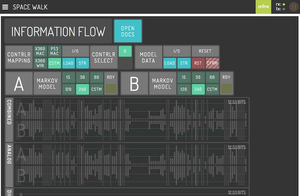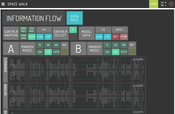Information
- Publication Type: Master Thesis
- Workgroup(s)/Project(s):
- Date: November 2015
- Date (Start): 31. January 2014
- Date (End): 9. November 2015
- TU Wien Library:
- Diploma Examination: 9. November 2015
- First Supervisor: Michael Wimmer
- Keywords: formal models of play, user input visualization, understanding interaction in games, gameplay, information theory
Abstract
This thesis proposes a formal model of interaction in games, to be used as tool for game analysis and game testing. The model allows a quantification of interaction by looking at the low-level structure and patterns in game-controller input. The game-controller input is modelled using discrete-time, discrete-space Markov chains, and information theory is used to quantify the mismatch between the model’s prediction and the actual user input.The model uses game-agnostic game controller data as its input, which is the lowest common denominator for a large class of games (almost all game console games, most PC games). The models are trained dynamically on-the-fly for each individual play session. This allows performing individual analyses of players’ interactions, while still retaining an approach that is very general and can be used with different games without modification.
To adapt to new play situations quickly, the used models are only based on data from the last couple of seconds or minutes. This can lead to the problem that not enough samples may be available to confidently estimate all dynamic model parameters. This problem is mitigated by considering the full probability distribution of each parameter instead, using a beta distribution.
This work contributes to the understanding of interaction in games, modelling of raw user input and quantifying the model output using information theory. The described approach has been implemented in software and preliminary results from a prestudy are available.
In this exploratory prestudy, the post hoc analysis of nine different games from various genres revealed a number of interaction patterns. One of the observed patterns is routinization, a process in which an action is performed repeatedly until it is executed almost unconsciously. Research in this field, based on this thesis, has been performed in cooperation with Martin Pichlmair from the IT University Copenhagen, and a workin-progress paper is to be published in the proceedings of the ACM SIGCHI Annual Symposium on Computer-Human Interaction in Play (CHI PLAY) [Wallner, S., Pichlmair, M., Hecher, M., and Wimmer, M. (2015). Modeling Routinization in Games - An Information Theory Approach. In Proceedings of the Second ACM SIGCHI Annual Symposium on Computer-human Interaction in Play, page pp, London, UK. ACM.]
Additional Files and Images
Additional images and videos
Additional files
Weblinks
No further information available.BibTeX
@mastersthesis{wallner-2015-InfoTheoryPlay,
title = "Applying Information Theory to Formal Models of Play",
author = "Simon Wallner",
year = "2015",
abstract = "This thesis proposes a formal model of interaction in games,
to be used as tool for game analysis and game testing. The
model allows a quantification of interaction by looking at
the low-level structure and patterns in game-controller
input. The game-controller input is modelled using
discrete-time, discrete-space Markov chains, and information
theory is used to quantify the mismatch between the
model’s prediction and the actual user input. The model
uses game-agnostic game controller data as its input, which
is the lowest common denominator for a large class of games
(almost all game console games, most PC games). The models
are trained dynamically on-the-fly for each individual play
session. This allows performing individual analyses of
players’ interactions, while still retaining an approach
that is very general and can be used with different games
without modification. To adapt to new play situations
quickly, the used models are only based on data from the
last couple of seconds or minutes. This can lead to the
problem that not enough samples may be available to
confidently estimate all dynamic model parameters. This
problem is mitigated by considering the full probability
distribution of each parameter instead, using a beta
distribution. This work contributes to the understanding of
interaction in games, modelling of raw user input and
quantifying the model output using information theory. The
described approach has been implemented in software and
preliminary results from a prestudy are available. In this
exploratory prestudy, the post hoc analysis of nine
different games from various genres revealed a number of
interaction patterns. One of the observed patterns is
routinization, a process in which an action is performed
repeatedly until it is executed almost unconsciously.
Research in this field, based on this thesis, has been
performed in cooperation with Martin Pichlmair from the IT
University Copenhagen, and a workin-progress paper is to be
published in the proceedings of the ACM SIGCHI Annual
Symposium on Computer-Human Interaction in Play (CHI PLAY)
[Wallner, S., Pichlmair, M., Hecher, M., and Wimmer, M.
(2015). Modeling Routinization in Games - An Information
Theory Approach. In Proceedings of the Second ACM SIGCHI
Annual Symposium on Computer-human Interaction in Play, page
pp, London, UK. ACM.] ",
month = nov,
address = "Favoritenstrasse 9-11/E193-02, A-1040 Vienna, Austria",
school = "Institute of Computer Graphics and Algorithms, Vienna
University of Technology ",
keywords = "formal models of play, user input visualization,
understanding interaction in games, gameplay, information
theory",
URL = "https://www.cg.tuwien.ac.at/research/publications/2015/wallner-2015-InfoTheoryPlay/",
}

 Poster
Poster Thesis
Thesis


